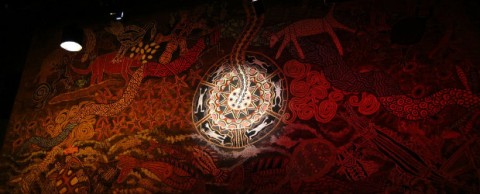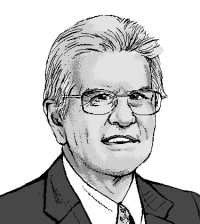The spirit of Dreamtime

Thirty thousand years ago, Europeans were creating the treasuries of cave paintings that so amaze modern observers. Yet even as those works were being painted, humans had already been settled in Australia for at least 20,000 years. Through most of their vast time on that continent, Australia’s indigenous peoples—Aboriginals and Torres Strait Islanders—lived in isolation from other human communities. They have had many millennia to familiarize themselves with every aspect of their land and to make it the basis of a profound spirituality. Only in very recent times have Western Christians begun to acknowledge and respect those ideas.
Aboriginal faith is rooted in the sanctity of nature and the landscape, every aspect of which carries a story or myth. The origins of all things are traced to a Dreamtime, an archaic mythical universe. That realm can be visited today through dreaming or through rituals that induce ecstasy or mystical experience. The standard Western distinction between sacred and profane worlds simply does not exist. Nor does the concept of linear time, with its rigid divisions between past, present, and future. Dreams and stories unite the whole known universe, everywhere and everywhen.
Read our latest issue or browse back issues.
In 1770, after some earlier contacts with the continent, Europeans began the systematic occupation of territory they claimed under the legal doctrine of Terra nullius, “Nobody’s Land.” Under that principle, Australia was a blank slate, a vacant territory awaiting possession and exploitation.
Later Aboriginal history is woefully familiar to anyone who knows about the experience of native peoples in North America. Under paternalistic theories of wardship, Australian governments exercised supervision over Aboriginals, while weaning them from their “savage ways.” Missionaries and social workers tried, often heroically, to assist their charges, but at various times authorities removed children from their communities and families. Many Aboriginal communities fell apart, and survivors drifted to urban slums, where they took refuge in drink and drugs. It’s not overstating the case to speak of cultural genocide.
Not until the 1970s did governments radically change their approach, enforcing treaty rights and curbing the worst abuses. More favorable laws and social attitudes have meant that Australia’s indigenous population has almost doubled in the last 25 years to about half a million, or 2.5 percent of the national total.
Most white Australians now appreciate the artistic and spiritual treasures that had existed so close to them throughout their history. In 2006, the film that won all the country’s major cultural prizes was Ten Canoes, which was filmed entirely in Aboriginal languages.
That early blindness toward the existence of native populations applied with special force to their spiritual views. White commentators commonly denied that Aborigines had a recognizable religious system—it was nothing but some childish folktales about snakes and kangaroos! Surely, thought the missionaries, the lack of a rival faith should make it fairly easy to bring indigenous peoples into the light of Christian truth.
At least according to official statistics, Christians have had a major success in evangelizing the Aboriginal world. Three-quarters of indigenous people declare themselves Christian, a high figure for secular Australia. A mere 1 percent of Aboriginals, just a few thousand souls, report practicing their traditional religion. Most of the remainder profess no religion. Most of the Christians are Catholic or Anglican, although Pentecostals have grown mightily in recent decades.
Through most of their history, Christian churches demanded that converts forsake traditional religious ideas and “pagan practices,” and modern-day Pentecostals are especially strict in these matters. In recent times, though, Christian thinkers have struggled to rethink the relationship between the new faith and its ancient counterpart, seeking to root Christianity in the land and the Dreaming. The most quoted such work is Rainbow Spirit Theology, produced in 1997 by a multidenominational group of Aboriginal Christians from Queensland. The whole text is a heroic attempt to reconcile the Euro-American North with the Aboriginal South.
Aboriginal thinkers present their traditional faiths as a kind of Old Testament precursor to the Christian message, one of the many and various ways in which God spoke to our ancestors. The name “Rainbow Spirit” refers to the common myth of the serpent that acted as a creative force in the Dreamtime. Christians generally dismissed this story as a crude Creator myth, with uncomfortably satanic connotations. Actually, these traditional peoples respond, the Rainbow Serpent is a critical symbol of life and fertility, more comparable to the Holy Spirit, whose actions transcend time. Moreover, indigenous peoples acknowledge Christ as one who takes their own form.
In 2020 Australia will celebrate a quarter millennium of European contact. That commemoration provides a wonderful opportunity for churches to proclaim a wholly transformed attitude toward indigenous traditions. Call it a dream.







